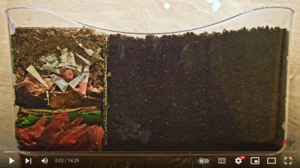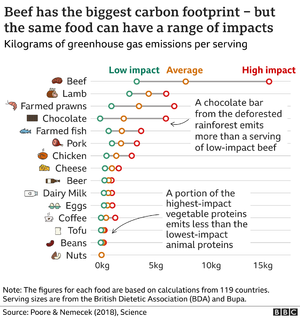Drawdown UK
Drawdown is an organisation that has researched and compiled a list of the 100 most-impactful ways to prevent CO₂ emissions and reduce the CO2₂ levels in our atmosphere as quickly as possible, most of which are already available.
You can watch a TED Talk about it here, and you can see the list of solutions here.
This page will be a curated list of ways people in the UK can take action on the list items, in order of priority.
1. Onshore wind turbines
147.72 gigatons CO₂ equivalent reduced/sequestered (2020–50). Drawdown page.
Onshore wind turbines are wind turbines/farms on land that collect wind energy and convert it to electricity. (As opposed to offshore, where the turbines are found out to sea.)
Individual action
- Switch your electricity provider to Good Energy. They match all the electricity you use over a year with electricity sourced purely from renewables, of which 54% is from wind.[1] Investing in wind power and depriving fossil fuel companies of your money will help the wind power industry to grow.
2. Utility-scale solar photovoltaics
119.13 gigatons CO₂ equivalent reduced/sequestered (2020–50). Drawdown page.
Utility-scale solar photovoltaics means large industrial-scale solar power generation, basically solar farms. A well-known example is fields full of solar panels. (As opposed to distributed solar photovoltaics further down the list, which is when people install smaller numbers of solar panels to supplement their electricity supply, or put solar panels on things like street lighting.)
Individual action
- Switch your electricity provider to Good Energy. They match all the electricity you use over a year with electricity sourced purely from renewables, of which 13% is from solar.[1] Investing in solar power and depriving fossil fuel companies of your money will help the solar power industry to grow.
3. Reduced food waste
94.56 gigatons CO₂ equivalent reduced/sequestered (2020–50). Drawdown page.
This one is mainly focused on preventing food waste as early in the chain as possible. In poorer countries it happens earlier, at farms or in storage/distribution. In richer countries more waste happens later on, with people buying more food than they need, or restaurants serving large portions.
Preventing food waste at earlier parts of the process prevents CO₂ emissions from overproduction. Preventing food waste at later parts of the process prevents methane production in landfill.
Individual action

- If you have a garden, get a compost bin, for uncooked plant-based food.
- Look into food waste collection from your local council, for cooked food, meat and dairy.
- Check the reduced food section in supermarkets to use up almost-expired food before it gets thrown out by the supermarket.
- Write the dates on food in your fridge so you can eat it before it goes off.
- Buy unwrapped vegetables by weight instead of in larger bags, so that you only have as much as you need.
Resources
- Share Waste. A website that matches people with compost bins to people who want to compost. You can offer up your compost bin and tell people what you're willing to compost, or you can find a neighbour with a compost bin and start putting things in their bin. Very useful if you don't have a local food waste collection service.
4. Plant-rich diets
91.72 gigatons CO₂ equivalent reduced/sequestered (2020–50). Drawdown page.
Drawdown emphasises that it's not about whether or not we eat meat, but about fair distribution of healthy food. In some countries people don't have enough access to quality protein. In the UK our diets tend to be very meat-centric, resulting in overconsumption of resources and overproduction of CO₂.
Individual action

We don't need to stop eating animals and animal-based products, but here in the UK we could do with reducing it. Here are some things I've often heard of people doing that have a positive impact. Some methods may be more or less appropriate depending on things like your income and social habits.
- Eat meat or fish only when eating out, as a treat.
- When buying food on the go, if faced with an otherwise equal choice, choose the vegetarian/vegan option.
- Meatless Mondays - eat no meat or fish on Mondays (or whatever day of the week is convenient for you).
- Choose meats that have a lower environmental impact. Cows and other ruminants are very resource-intensive, but pork and chicken are better.[2]
- Buy local, ethically-sourced meat. It tends to be more expensive, which might lead to buying or wasting it less often.
5. Health and education
85.42 gigatons CO₂ equivalent reduced/sequestered (2020–50). Drawdown page.
This euphemistically refers, basically, to feminism. It is focused on:
- Educating women and girls. Educated people are more able to contribute to efforts to reduce and prevent climate change, and because educated people tend to have fewer children.
- Family planning. Access to birth control and abortion results in people growing families out of choice, which lowers both human suffering and future CO₂ levels. Educations and careers are less likely to be derailed by having unplanned children.
In most of the UK, to get an abortion, two doctors are required to sign and confirm that continuing the pregnancy would threaten the physical or mental health of the pregnant person or their family. Abortion is still very much a moral issue, and in some areas (such as in Northern Ireland) access to services is stigmatised or very limited.
Causes to support financially
- Abortion Support Network. Donations go directly to supporting pregnant people to access abortion. Ways include funding travel to clinics, funding accommodation, and funding private treatment. Volunteers provide emotional support and sometimes accommodation.
- Friends of BPAS. Donations go towards campaigning for women's reproductive rights.
6. Tropical forest restoration
85.14 gigatons CO₂ equivalent reduced/sequestered (2020–50). Drawdown page.
7. Improved clean cookstoves
72.65 gigatons CO₂ equivalent reduced/sequestered (2020–50). Drawdown page.
Cooking methods that use fossil fuels and wood "produce 2 to 5 percent of annual greenhouse gas emissions worldwide. They stem from two sources. First, unsustainable harvesting of fuel drives deforestation and forest degradation. Second, burning fuels during the cooking process emits carbon dioxide, methane, and pollutants from incomplete combustion that include carbon monoxide and black carbon."
Gas cookers increase risk of childhood asthma and worsen existing asthma.<ref>Meta-analysis of the effects of indoor nitrogen dioxide and gas cooking on asthma and wheeze in children, International Journal of Epidemiology, 20 August 2013.
Individual action
Favour electric hobs and ovens.
8. Distributed solar photovoltaics
68.64 gigatons CO₂ equivalent reduced/sequestered (2020–50). Drawdown page.
9. Refrigerant management
57.75 gigatons CO₂ equivalent reduced/sequestered (2020–50). Drawdown page.
10. Alternative refrigerants
50.53 gigatons CO₂ equivalent reduced/sequestered (2020–50). Drawdown page.
References
- ↑ 1.0 1.1 Good Energy's electricity sources. Captured Oct 2020.
- ↑ 2.0 2.1 Climate change food calculator: What's your diet's carbon footprint?, BBC News, 9 August 2019